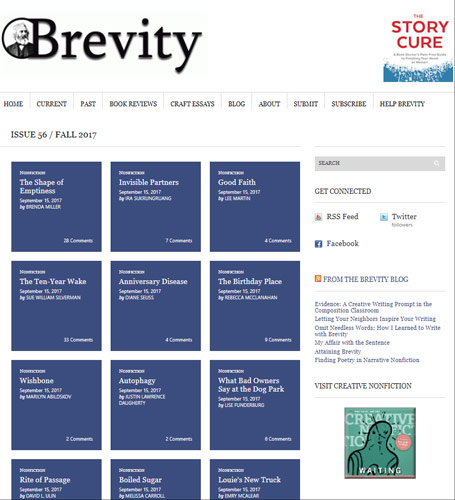Brevity – September 2017
Celebrating their 20th anniversary, Brevity is a staple in both concise writing, and skillful nonfiction. An assignment in my first creative nonfiction class years ago was to browse the online journal’s website and pick out pieces we admired, and since then, Brevity is a magazine I revisit often, knowing I will never be disappointed by what I find there. As one might expect out of an anniversary issue, the September 2017 edition contains masterful nonfiction, exemplary of the quality work readers have come to expect.
Celebrating their 20th anniversary, Brevity is a staple in both concise writing, and skillful nonfiction. An assignment in my first creative nonfiction class years ago was to browse the online journal’s website and pick out pieces we admired, and since then, Brevity is a magazine I revisit often, knowing I will never be disappointed by what I find there. As one might expect out of an anniversary issue, the September 2017 edition contains masterful nonfiction, exemplary of the quality work readers have come to expect.
Diane Seuss keeps to the theme of anniversaries with “Anniversary Disease,” a one-paragraph piece that looks at the fact that “[e]very day is the anniversary of something,” resulting in anniversaries of personal moments sharing dates with broader-reaching anniversaries:
On May 29th of 1913 a riot was incited by the first performance of Stravinsky’s “The Rite of Spring.” On the same date in 1919, Charles Strite filed his patent for the pop-up toaster. May 29th is also the anniversary of my father’s birth.
Despite the more major event, the personal becomes the bigger, more major occasion that sticks in our memory. The title “Anniversary Disease” comes from the bodily phenomenon of becoming ill on or near the anniversary of a traumatic event, demonstrating the ways these anniversaries affect us year after year. In Seuss’s case, it is the anniversary of her wedding to her ex-husband, and similarly to how anniversaries are linked. Seuss seamlessly links her Anniversary Disease to another major anniversary: “the day in 1184 B.C. the Greeks entered Troy in the belly of the Trojan horse [ . . . ] the enormous wooden wheels rumbling over the earth and through the gates of the unsuspecting city,” perhaps in the same unsuspecting way Seuss entered her marriage.
Another major life event—or two—is explored in the 150-word piece “Rite of Passage” by David L. Ulin, which begins: “My mother claims it was my brother’s bris that made her turn from Judaism.” An important religious event for her son becomes an important, personal, and religious event for Ulin’s mother. He watches the home video footage of this occasion, absorbing the details, and studying his mother as he tries to pinpoint the moment she turned away from her faith. Ulin prompts readers to consider the moments when the people we care about encounter a big change and how there’s no way we can always know their experiences. Like with his mother, whose “demeanor—her face, her posture—does not change,” we can’t always notice those inner changes of others.
In “The Ten-Year Wake,” Sue William Silverman demonstrates a scenario in which the person she once confided her changes in is no longer there to speak to. Returning to Atlanta after moving to Michigan years prior, Silverman seeks to speak to her former therapist, Randy, only to discover that he passed away just two days prior. Silverman is hit with the weight of his death without warning and struggles to come to terms with it, sitting alone in his office. She shares:
While still in Michigan, before flying to Georgia, I receive an e-mail from Randy only a few hours before he dies. I had e-mailed him first, earlier, telling him I look forward to seeing him, but am nervous, since it’s been a long time.
He writes, “I’m still here. Everything will be fine.”
Reading those words and picturing the person who wrote them—and the person receiving them—is heartbreaking. Silverman seems unmoored, lost as she readies herself for a funeral she didn’t expect to attend. After ten years, she finally finds it in her to return Randy’s email, the short, poignant nonfiction piece her reply, a beautiful tribute to her former confidant and friend.
There is more to discover in this anniversary issue of Brevity, including pieces that utilize a less traditional format. Justin Lawrence Daugherty’s “Autophagy” is all one sentence, a run-on, rambling piece that circles around itself and strings readers along while never quite losing them. Lauren Crux’s “Little Rambles (Excerpts)” is made up of letters, each one giving readers something a little philosophical to consider, all written with good humor.
Two writers bring their brevity in the form of lists: Lise Funderburg and Kirsten Kaschock. Funderburg’s “What Bad Owners Say at the Dog Park” is just as it advertises—a list of excuses one might hear at the dog park. The offending dog, Pookie, is into all sorts of trouble, resulting in phrases like: “9. Pookie, come! Come, Pookie! Are you listening? If you don’t come right now, Pookie, we’re going to have to leave the park. Do you want to leave the park, Pookie?” or more simply: “18. Pookie, no!” To a dog owner, the piece straddles the line between humorous and irritating, a realistic and creative take on an everyday event.
Kaschock takes her list in a different direction, the subject matter more serious in “Things I Did Between the Follow-Up Mammogram and the Ultrasound.” These things begin with the everyday and mundane, to things closer to the current situation, like “11. Wondered what it’d be like to stop shaving my legs. Not my armpits. Don’t think I’d like the feeling of hair there. Wondered what it would be like to have no breasts.” At the end of the list, we don’t have test results or an answer on whether everything will be okay, but it isn’t necessary. Kaschock fulfills her goal in sharing her tense, waiting, in-between time with readers, giving us just enough—exactly what the title promises. Kaschock shares a deeply personal moment and writes about it so openly without shying away, a piece to be read multiple times.
After making their way through the creative pieces, readers should take time to check out the Editor’s Note, which gives the magazine’s history, as well as a glimpse at what Brevity looked like at its conception. Editor Dinty W. Moore reveals: “Once or twice every year I decide to just shut the entire operation down because it takes so much time and effort, but then I hear from folks how much they value the magazine, and I say, ‘Okay, one year more.’” I’ll gladly join the chorus of folks chanting “One more year” every year.
[www.brevitymag.com]






